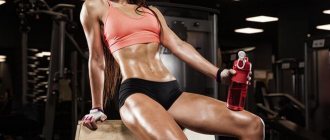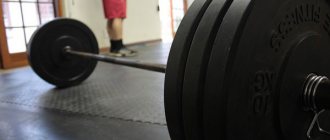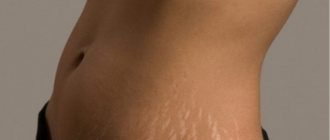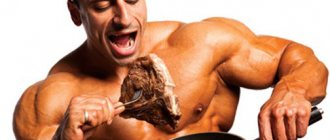The older we get, the more changes occur in our body. Agree, we cannot feel like 25-year-olds forever. The inevitable aging of the body is something that every person will have to face. However, this is not a reason to give up and admit defeat. In this article we will tell you whether it is possible for a 50-year-old man to build muscle, how to prevent negative age-related changes, even how to gain muscle mass at an older age.
- Sarcopenia – why muscle mass decreases with age
- What causes muscle loss after 50?
- Symptoms of sarcopenia
- How to prevent sarcopenia and build muscle after 50 Workout: Exercise to strengthen your body Physical activity
- Power training
- Aerobic exercise is also very beneficial
- Workout 1
- No. 1. Protein, aka protein
- Move more
Sarcopenia – why muscle mass decreases with age
Losing muscle mass with age is an absolutely natural process. This age-related change in skeletal muscle is called “sarcopenia,” which literally means “lack of flesh.” Sounds scary, doesn't it? However, the sooner this condition is identified, the easier it will be to reverse it.
Around the age of 30, the male body begins to lose some of its mass. Of course, you don't have to worry about your muscle mass disappearing as soon as you turn 30. However, you should know that every decade your total muscle size will decrease by 3-5%. Experts say that by the end of life, most men will lose about 30% of their skeletal muscle volume.
As you can imagine, the older you get, the more noticeable these changes become. It’s easy to calculate that by your 50th birthday your body will have lost 6-10% of the muscle volume you had at 25 years old. Add to this the age-related decline in testosterone levels, and you get a frustrated man with saggy muscles.
But you should not perceive a decrease in muscle mass as an absolute defeat in front of nature. On the contrary, let this process serve as a signal for you to act. Fortunately, sarcopenia can be slowed down and muscle size can even be increased after age 40-50 and into older age.
Consider how sarcopenia can not only weaken you physically, but also reduce your overall quality of life. If these reasons are not enough to make you move, then think about this...
Scientists believe that sarcopenia is one of the main risk factors for morbidity and mortality in people over 65 years of age.
Yes, ignoring the signs of this disease, you are guaranteed to lead yourself to an early grave. Let's see what you can do to avoid this.
How can a 45 or 50 year old man get pumped up without harming his health?
In this section, we'll look at the barbell exercises you should do, as well as alternatives if your joints can't handle some of the exercises.
If you haven't lifted a barbell for a long time, start with other strength exercises for at least two days. In between these two days, leave one day without exercise to allow your muscles to rest and recover.
Take the exercises slowly and don't sacrifice proper form to lift more weight.
Many people, even before they reach fifty years of age, begin to have problems with the joints of their shoulders and knees, and therefore you may not perform some of the exercises on this list.
Bench press
The bench press is a very important exercise that benefits the entire upper body.
When you're just starting out, it's a good idea to use a dedicated bench machine so you can focus on technique rather than stabilizing the bar.
You can also work with a heavy barbell in a machine, and then perform several repetitions with a light barbell, but without a machine.
The bench press does not increase muscle size, but trains the entire body and stabilizes its response to stress.
This way, when you move on to working with free weights, your body will already have experience and it will be easier for you to get started.
Dumbbell press
The dumbbell shoulder press is another essential upper body exercise.
It improves overall body functioning and can even reverse the age-related changes your body has experienced and muscle loss.
This exercise is a great option because it works all three deltoid muscles.
Upper block pull
This exercise is good for your back muscles.
Vertical block rows are performed on a special simulator. The exercise also targets the arm muscles.
The good thing about the simulator is that exercises on it can be done completely safely for muscles and ligaments.
Hands should be kept as vertical as possible during the exercise.
Dumbbell Curls
Bicep curls build your biceps and strengthen your triceps.
But if you have pain in your elbow joints, then exercise with free weights should be avoided. Use a trainer instead.
The simulator allows you to fix your hand on a stand, which will ensure correct technique and reduce the load on the joints.
Also, the machine will not allow the back muscles to do part of the work, which will also prevent back pain. Also pump up your triceps.
The triceps exercise works the same way as the biceps exercise, only in reverse. An arm rest minimizes stress on the elbow and prevents sprains.
Squats
It will be more difficult to pump up your legs because many people over fifty already have pain in their knees or hip joints.
If you are lucky enough to have no joint problems, you can do traditional squats. To stabilize the movement during squats, use a Smith machine.
The Smith machine simply secures the barbell with the weight so that it does not move to the sides when you perform squats.
But if your legs hurt, then you shouldn't use weights at all. Try squats without a barbell.
Leg press
The leg press machine takes the stress off your knees and hips.
Instead, you sit with your back at a 45-degree angle. You push a flat surface with your feet. This exercise is good for the quadriceps and gluteal muscles.
If you want to specifically pump up any specific muscle groups, talk to a trainer.
He will select special exercises for you that will help you achieve the results you need.
What causes muscle loss after 50?
According to statistics, sarcopenia affects about 10% of all people over 50 years of age. If left unchecked, this disease can lead to a significant deterioration in your quality of life, not to mention changing your physique for the worse.
Scientists have concluded that sarcopenia occurs as a result of a lack of balance between two signals to muscle cells - a signal for cell growth and a signal for destruction. In a healthy young person, the number of signals for growth and destruction of muscle cells is almost the same.
The process by which muscle cells grow is called “anabolism,” and the process by which they break down is called “catabolism.” Both of these processes usually occur simultaneously, thus maintaining a dynamic balance of cells in the body. First, muscle cells are destroyed, then restored - as simple as shelling pears.
But once a man crosses the threshold of his 30th birthday, things get a little more complicated...
As men age, they develop resistance to anabolic growth signals and the scales tip toward catabolism, which we now know is the cause of muscle tissue degradation.
In short, a person begins to lose more muscle tissue than his body is able to build. Over time, this process leads to a noticeable reduction in total muscle mass - sarcopenia.
As men age, they develop resistance to anabolic signals that cause cell growth
Symptoms of sarcopenia
You've probably already caught yourself thinking that 20 years ago your biceps were much bigger, but now you can't understand where all those curves went?
Yes, sarcopenia is not so easy to recognize, because the signs of this disease are often hidden.
Here are some common symptoms of muscle loss:
- You feel physically weaker
- You are experiencing unintentional weight loss
- Decrease in strength indicators
- Decreased stamina
- Your running or walking pace has noticeably slowed down
- You have problems with balance
- No desire to move or exercise
- You find it more difficult to cope with normal daily tasks
Another surefire way to detect sarcopenia after 50 is to do a grip strength test . To do this, you can purchase a special device for measuring grip strength, called a hand dynamometer, and use it yourself, or consult a doctor.
According to the researchers, for men, an estimate of 30 kg or less is considered insufficient. However, researchers caution that loss of strength is not always a direct symptom of sarcopenia.
Reduced muscle levels can also be determined by checking the skeletal muscle mass index using a special test. This test will calculate the ratio of muscle tissue to other tissues in your body.
How to prevent sarcopenia and build muscle after 50
Just the thought of sarcopenia can cause anxiety. But, believe me, there are an incredible number of ways that will help you not only avoid weight loss, but also increase it!
By following these simple tips, you can protect your body from unnecessary damage.
Workout: Exercise to strengthen your body
A question that worries many: “Is it possible to do fitness in old age? Will this harm your health? The answer is simple: not only is it possible, but it is necessary! Regular training is one of the most effective and also fun ways to take care of your muscles. Don't miss the opportunity to get the maximum benefit for yourself and your body!
Physical stress
Additional exercise after age 50 for men and any moderate strength training is extremely important when it comes to building mass. This is proven by the results of one study, which involved 1,328 men over 50 years of age. Those who performed exercises with additional weights experienced significant gains in mass compared to those who did not train in this way.
The researchers concluded that resistance training is very effective for gaining lean muscle mass in older adults, especially in higher-volume training programs.
The researchers also added that resistance training is extremely effective earlier in life.
Power training
Strength training is needed not only to “pump up” muscles. Strength training exercises utilize many of the functional movements you do in your daily life. You will feel how your strength has increased, and your movements have become faster and more coordinated.
Aerobic exercise is also very beneficial
It is important not to forget about aerobic exercise. Even though weight training will keep your muscles toned, cardio exercises combined with strength training will bring you many benefits. Walking, jogging, cycling - all this will help you in the fight for your muscles.
Don't worry if you can't go to the gym six days a week. Scientists say that two to four cardio workouts a week is enough to keep you in good shape.
Bodybuilding helps you gain weight by increasing muscle mass at any age, whether you are 40, 50 or even 60 years old!
At 50, everything is just beginning: how to train if you are no longer young
Photo: m24.ru/Vladimir Yarotsky
In July, social network users actively discussed the dance of millionaire Italian Gianluca Vacca with his young wife Georgia Gabriela. And perhaps this dance would not have attracted such attention if it were not for Gianluca himself, who at forty-nine years old looks simply amazing. His plasticity and ability to move deserve special attention, and the dance itself is distinguished by a certain originality. Gianluca’s figure, without a doubt, arouses the envy of many men, even those younger in age, especially since most people associate rich men with fat, clumsy men on expensive yachts surrounded by young models. Read about how to stay in shape if you are no longer 20 years old in the material of m24.ru columnist, fitness trainer and TV presenter Eduard Kanevsky.
It is people like Gianluca who destroy stereotypes. His Instagram contains many photographs of a “beautiful life”, a happy family, tattoos, but there are also photos and videos from his training, including in the gym. Regular training, proper nutrition and proper motivation are his secret to youth – it couldn’t be any other way. This means that absolutely every man can look the same and even better if he changes his lifestyle - watching TV with a bottle of beer - for an evening jog in the park. And there is no connection with the wealth of the hero of my article and his physical fitness, because for regular training, sometimes you don’t even need any equipment or specialized gyms at all; the main problem of most people is laziness.
But how to start training if the last time you were at a stadium or gym was five, ten, or maybe even twenty years ago? Or have you never really worked at all? How to start training if you are no longer twenty years old, and perhaps, like the hero of this article, are already approaching 50 years old? About this in this article, which is dedicated specifically to men aged forty plus. But young guys also have something to learn from it, because it’s not only adults who “let themselves go.”
Where to begin?
If you have decided to finally take care of your figure, first you need to understand what is wrong with your health. It is no secret that a sedentary lifestyle, physical inactivity, and poor nutrition lead to serious health problems. Including from the cardiovascular system, digestive organs, musculoskeletal system, and so on. Therefore, I recommend undergoing a good old medical examination without fail to anyone who has finally decided to take care of themselves. If you are obese, I recommend visiting a nutritionist’s office, since obesity can lead to serious restrictions on certain physical activities. Also, without fail, you will need to consult a doctor - exercise therapy. The more you weigh, the more restrictions you have, and they must be taken into account when planning your workouts.
Photo: m24.ru/Vladimir Yarotsky
First training
There is nothing worse than a quick result; moreover, often a quick result has the opposite effect. This is especially true for people who want to lose weight. In dietetics, this is called the “yoyo effect”, when a person, using incorrect diets or even starvation, suddenly loses tens of extra pounds, and then, by eating too much, gains more than he lost. Actually, even if you decide to lose weight through physical activity or want to gain muscle mass, also with their help, and you are no longer 18, do not strive for obvious results in a short time at all. You can seriously harm yourself, particularly by getting seriously injured. Remember, the slower the result, the more stable it is.
It was not for nothing that I mentioned a specialist in physical therapy training. If during your health check no pathologies were identified, then you are lucky and you can train in almost any area of the fitness club or on the street, because running, rollerblading or cross-country skiing in winter are not prohibited for you. But what to do if you have gained dozens of extra pounds, which severely limit movement and increase the risk of injury? Yes, you need to contact a specialist. But if you don’t have the opportunity to get to one, it’s okay, because for people with excess body weight there is always a universal tool - water. The main advantage of training in water is the reduction of stress on the joints and spine, as well as the intense impact on all the muscles of the body, which enhances the effect of the workout with an inevitable increase in calorie consumption. The best activity in water is water aerobics, which many men pointedly ignore, saying that only women do it. Although, this is the stupidest excuse if you have problems with excess weight and you really want to lose weight. But on land there is an alternative for independent training. Firstly, this is fast walking over rough terrain; if the load is not enough for you, then try Norwegian walking with special poles. Your main task is to start training regularly.
How often and for how long?
In the first stages of training, three sessions per week for 45 minutes are enough. In the future, you can increase the duration of the lesson to an hour, an hour and twenty, but this time will include a warm-up before training and a mandatory cool-down at the end. Any full workout lasts strictly an hour. Remember, you are no longer teenagers whose recovery after training occurs many times faster than yours. Moreover, you can harm yourself by training for too long.
Photo: m24.ru/Vladimir Yarotsky
Gym
The gym is an essential part of training for men, not only from the point of view of building a good figure, but also from the point of view of the functioning of the whole body as a whole. The fact is that muscles do not grow without the male hormone testosterone, the level of which inevitably decreases with age. That’s why men over 40 need strength training so much, as a real “means” to prolong male youth. Strength training has been proven to increase levels of the main male hormone.
But you need to exercise as carefully as possible in the gym. Gradually learning the technique of performing a particular movement, slowly increasing the weight of the weight and in no case trying to set “strength records.” The optimal work regimen for men after forty is 15-20 repetitions of three sets in the first month of training. In the future, the number of repetitions can be reduced to 12-15.
You can be active, beautiful and slim at any age, the main thing is to really want it. Remember, quality of life is determined not only by the thickness of your wallet, but also by how you feel and look.
Plot: Life in Ri with Eduard Kanevsky
Workout Options for Men Over 50
Full body workouts will help you restore muscle tone and avoid muscle loss. You can pump up your muscles in old age thanks to this method of low-impact strength training, which was developed specifically for men over 50 years old. These workouts are aimed at working all the major muscle groups in your body.
Training scheme: sets of exercises alternate with each other and are performed separately on different training days. For example, today you perform exercises from the first training complex, and tomorrow or every other day you perform exercises from the second training complex.
If your health allows you, then you can train using this method 4-6 times a week.
Workout 1
Warm-up:
5-10 minutes on a treadmill, arm circles (15 forward and 15 backward rotations), 10 forward bends, leg swings (10 swings of each leg back and forth and sideways), 10 air squats.
Exercises:
- Lunges with dumbbells forward – 2-3 sets of 8 repetitions on each leg
- Dumbbell bench press – 2-3 sets of 10 reps
- Dumbbell overhead press – 2-3 sets of 8 reps
- Wide grip lat pulldown – 2-3 sets of 12 reps
- Alternating dumbbell curls for biceps – 2-3 sets of 10 repetitions
- Plank – 1-2 sets of 30 seconds
Hitch:
5-10 minutes of slow running on a treadmill, static stretching.
Doing these exercises will help you strengthen the muscles in your arms, shoulders and back.
Workout 2
Warm-up:
5-10 minutes riding an exercise bike, arm circles (15 forward and 15 backward rotations), 10 forward bends, leg swings (10 swings of each leg back and forth and sideways), 10 air squats.
Exercises:
- Goblet squats – 2-3 sets of 10 reps
- French dumbbell press for triceps with both hands – 2-3 sets of 10 repetitions
- Lying dumbbell raises – 2-3 sets of 10 repetitions
- Dumbbell lateral raises – 2-3 sets of 12 repetitions
- Close-grip lat pull-down – 2-3 sets of 12 reps
- Plank – 1-2 sets of 30 seconds
Hitch:
5-10 minutes of slow cycling on an exercise bike, static stretching.
For these exercises, it is necessary to use such a weight of weights that will not allow you to relax and forget about the workout.
If you have enough strength to squeeze out 1-2 more good reps, then do them!
As you get stronger, consider increasing the load. You can do this by increasing the weight of the weights or the number of repetitions. Remember that progression of training is the key to guaranteed muscle growth.
Day 4: Belly Fat Workout
Many people dream of reducing their belly, but few people know that their health depends on their waist size. The thinner the waist, the lower the risk of cardiovascular diseases and problems with internal organs. This is due to a decrease in the level of visceral fat, which most often accumulates in the abdominal cavity. A set of exercises will help you get rid of excess fat in the abdomen and sides, maintaining the health and beauty of your body.
We recommend watching:
- Top 10 Abdominal Exercises for Beginners (No Planks)
- Active morning exercises for losing weight in the stomach: 20 exercises
Boxing + knee raises
Place your feet shoulder-width apart, bend your elbows and clench your palms into fists, pointing them forward. Lift one knee up and simultaneously perform a forward punch with both hands. Come back and lift the knee of the other leg, again performing a forward kick with both hands at the same time. The exercise can be performed after 55 years at home to lose extra pounds and strengthen the heart through cardio exercise.
How much to do: 25-30 knee raises.
Side bends
Stand straight, feet slightly wider than shoulder-width apart, hands on your waist. Raise your right arm up and at the same time lean to the left, stretching the right side of your body. Come back and repeat the bend on the other side. Bend-overs work the oblique abdominal muscles, as well as stretch the lateral muscles of the core and elongate the spine, which is beneficial for back health.
How much to do: 15-20 inclinations in total.
Knee adduction with palm touch
Place your feet shoulder-width apart, fold your arms in front of you, palms together and pointing down. Step back with your left foot and lift your knee up, bringing it toward your body. At the end of the movement, touch your knees with your palms and bring your leg back, and then immediately repeat the approach. Complete all reps on one leg and then the other. Exercise is included in the complex for women after 50 years, as it not only promotes weight loss, but also strengthens muscles, ligaments and joints.
How much to do: 20-25 knee pull-ups on one side, then 20-25 knee pull-ups on the other side.
Rotations of the body with outstretched arms
Place your feet slightly wider than your shoulders, extend your arms in front of you and bring the edges of your palms together. Turn to the right without changing the position of your arms and pelvis, only your core works. Then return to the starting position and turn to the left. Crunches are good for your abdominal muscles, but they also keep your spine mobile, open your chest, and relieve back pain.
How much to perform: 15-20 turns in total.
Rock climber supported by chair
Place your hands on the seat of a chair or sofa and take a lying position. The pelvis should be in line with the back and legs. Bend one knee and bring it towards your chest. Come back and repeat with the other leg. The lighter version of the “rock climber” is considered a good physical exercise for losing weight after 55 years, as it provides a gentle load on the joints, while strengthening the core and abs.
How much to do: 20-25 knee pull-ups in total.
Seated box crunches
Sit on the floor, bend your knees, place your hands near your chest, clench your palms into fists. Lean back a little and turn to the right, straightening your left arm and trying to touch the floor with it. Return to the starting position and twist your body to the left, now straightening your right arm. Exercise strengthens the abdominal and core muscles, trains balance and has a positive effect on back health.
How much to perform: 25-30 turns in total.
Bicycle with fixation
Lie on your back, straighten your legs and lift them slightly. Raise your head, tensing your abs, bend one leg at the knee and pull it to your chest with your hands, fixating at the extreme point for a few seconds. Straighten your leg and bend the other knee. Cycling is an effective abdominal exercise for women over 50 at home, which trains the deep muscles of the body and also improves blood circulation in the abdominal cavity and pelvic organs.
How much to do: 15-20 knee pull-ups in total.
Bends while lying down
Lying on your back, bend your knees, extend your arms along your body, but do not place them on the floor. Bend to the right, trying to reach your foot with your palm, and then immediately tilt to the left. Alternate bends, trying to reach your feet each time. The exercise works the obliques, as well as strengthens the core and improves spinal mobility.
How much to do: 20-25 inclinations in total.
Seated knee raise
Sit on the floor, bend your knees, raise your arms up and clasp your palms. Lean your body back and lift one knee towards your chest while lowering your arms towards it. Raise your arms up, returning your knee to its place. Repeat for the other leg. The exercise works the abdominal muscles and core, and also strengthens the back, hips and knees.
How much to do: 20-25 knee pull-ups in total.
Gluteal bridge
Lie on your back, bend your knees. Raise your pelvis up and tighten your gluteal muscles at the end point of the movement. Return to the starting position. In addition to benefiting the buttocks and thighs, the exercise also stretches the abdominal muscles, stimulating blood circulation in the pelvic and abdominal areas, which helps maintain women's health.
How much to perform: 12-15 repetitions.
Advanced practitioners can repeat the workout in 2-3 circles.
Diet: proper and balanced diet for muscle growth
Another way to stop weight loss in adulthood is to eat a healthy and balanced diet. A healthy diet doesn't have to be overly complicated, just make sure your diet includes foods rich in all the essential micro and macronutrients.
Proper nutrition can multiply the positive effect of your workouts. Carbohydrates and fats will fill you with the necessary energy, and protein will provide your body with building material for muscles. In addition, by consuming key vitamins and minerals, you can restart many important processes in the body.
Let's look at the most important components of proper nutrition that can help prevent weight loss. Below are four nutrients that have been found to be most effective in combating sarcopenia.
No. 1. Protein, aka protein
If you thought that protein was a substance that only bodybuilders used, then you were wrong. Protein is one of the most important macroelements that absolutely all mammals need for life.
Protein molecules are made up of tiny amino acids, which are the building blocks for all the tissues of our body. All cells in our body are made of protein, which is why it is extremely important for our life.
Remember we talked about the process of cell destruction and anabolism? So, if we consume enough protein, then protein synthesis starts in our body, stimulating cell growth. Therefore, the protein you just received with food plays a vital role in the restoration and maintenance of muscle volume.
If there is a shortage of this essential macronutrient in the body, then the condition of your muscles will begin to deteriorate. As you may already understand, protein deficiency in the body accelerates the onset of sarcopenia.
The body's need for protein changes with age.
Throughout our lives, the amount of protein we need changes. The older a man is, the more proteins should enter his body. This is because as we age, muscles become more resistant to growth signals.
Each amino acid plays an essential role in the growth process of muscle cells. However, scientists believe that leucine is the most important element in the process of cell growth.
You can find this essential amino acid in foods such as meat, fish, soy, milk and its derivatives.
Current research shows that men over the age of 50 should consume 25-30 g of protein with each meal.
No. 2. Vitamin D
It is also often called “sunny”. This vitamin got its name for a reason, because your body naturally produces it when sunlight touches your skin. However, in modern realities, not everyone can get enough sun during the day. And as we get older, the risk of vitamin D deficiency increases.
Scientists say there is a link between low vitamin D levels and sarcopenia. However, the reasons for this dependence have not yet been identified.
Men suffering from vitamin D deficiency can obtain it by taking special dietary supplements. It will also help increase testosterone levels, an important androgenic hormone that is involved in muscle growth.
Currently, the amount of vitamin D required to slow sarcopenia is unknown. However, if you are older and spend long periods of time indoors, you are likely getting less than the recommended daily intake of this vitamin.
No. 3. Creatine
Creatine is a nitrogen-containing carboxylic acid that is found in vertebrates. It is mainly synthesized in the liver and kidneys from various amino acids. This creatine is called endogenous. The creatine that enters our body with foods is called exogenous. It can be obtained together with protein products such as meat, eggs, milk and its derivatives. In addition, to saturate your body with creatine, you can use special creatine-containing nutritional supplements.
Creatine is an extremely important element for muscle function. As creatine phosphate, it is involved in high-energy communications between muscle cells during both high- and low-intensity physical activity. This is why creatine is so important for maintaining good physical shape.
Creatine supplements
Many athletes enjoy creatine supplements because of its specific properties that stimulate muscle growth and improve endurance. However, creatine-containing supplements can be used not only by professional athletes. If dosage recommendations are followed, this dietary supplement will be beneficial to all people, even those over 50.
Recent research suggests that supplementing your diet with creatine and strength training improved your physique more effectively than training without supplements. This means that the weight of the subjects increased, and body fat, on the contrary, decreased.
It is worth noting that this study did not involve 20-year-old athletes, but older people, including those over 50 years old.
Creatine will help you strengthen your muscles and protect them from sarcopenia. Additionally, creatine supplements are the cheapest and most common of all supplements available.
For men over 50 years of age, experts recommend consuming 5 grams of creatine per day along with a small amount of carbohydrates. In addition, taking this dietary supplement should be combined with progressive resistance training.
No. 4. Omega-3
Omega-3 fatty acids are known to be very beneficial for joints. But could these tiny oil capsules be even more beneficial?
Studies have shown that consuming omega-3 fatty acids helps increase muscle mass in people over 50 years of age.
Again, this result was shown not by young athletes, but by healthy older people. According to the scientists who conducted this study, omega-3 supplementation may even directly affect protein synthesis.
Omega-3 fatty acid supplements may help prevent muscle loss by improving protein synthesis.
Program for effective muscle growth
The growth of muscle fibers is stimulated by controlled damage that occurs as a result of specific exercises. Recovery occurs during sleep, but only if the person adheres to the correct diet.
Basic principles of the training process for those who want to pump up at 50 years old:
- Alternating loads. Older men The number of repetitions when working with heavy weights should vary from 5 to 12, with light weights - from 12 to 20. This load is enough to gain muscle mass. The duration of the workout should not exceed 1 hour. The cardiovascular system should not be overloaded.
- Load control. Exercises must be performed technically competently, and the weight must be selected correctly, since joint mobility decreases in old age. Breathing requires special attention. Therefore, you need to train only under the supervision of a specialist.
- Recovery. With age, recovery processes slow down, so you need to pay more attention to rest. In the absence of ailments and fatigue, a break of 2 days between workouts is quite enough.
- Diet. It must comply with the principles of a healthy diet and be formed taking into account the age and needs of the body. It is important to get a sufficient amount of carbohydrates before training, which are a source of energy and stimulate muscle growth. Otherwise, it is very difficult to build muscle mass.
Interesting articles:
Squats with a barbell on the shoulders - technique
How to restore license plates on a car
Healthy lifestyle: improving the quality of life will restore hormonal balance
You already know that the main suspect in weight loss is sarcopenia. But can the wrong lifestyle make the situation even worse? It certainly can. And if you slightly adjust your habits to reverse this negative process, will it help? Certainly! So let's put some effort into it right now and change our lives for the better!
Move more
One of the main reasons for muscle loss in men after 50 years is the lack of physical activity. Low testosterone levels can cause our energy levels to decrease. Besides, there is always a lot to do at work, so going to the gym is out of the question. And the children are already grown up, and you no longer need to chase them around the yard. In short, as people age, they tend to lead more sedentary lifestyles.
How to fix this situation? The answer is simple - move more. Let it be a walk from work to home, going up the stairs to your apartment rather than taking the elevator, or working out in the gym. Make a little effort to “stir up” your muscles so that they don’t go into hibernation. Don't miss the opportunity to make the most of your daily routine!
Eat right
As we said earlier, you should reconsider your diet. Of course, when it comes to maintaining your muscle size, protein is essential for the body, but don't forget about other nutritional components.
Eat a balanced diet rich in healthy fats, colorful fruits, crunchy vegetables and unusual sweet treats. By eating right, you will provide your body with all the necessary vitamins and minerals.
Take care of your testosterone
Finally, keep an eye on your testosterone levels, as this hormone is what gives you your masculine characteristics.
Once you reach middle age, your testosterone levels decline and will continue to decline throughout your life. This is a natural process, but it can be slowed down. However, if you don't put in enough effort, don't watch your diet, and don't exercise enough, your testosterone levels can drop to extremely low levels.
How to solve this problem? Take care of yourself : eat well, exercise, get enough sleep, and try to avoid unnecessary stress. Additionally, you may want to consider taking testosterone supplements to give your body additional support.
Day 5: Back and spine workout
Not only your posture, but also your overall well-being depends on the health of your back. With simple exercises, you will strengthen your back, improve the flexibility of your spine, work on your posture, and even get rid of pain in the lower back and neck caused by muscle tension.
We recommend watching:
- Exercises for the back while standing: prevention of scoliosis and osteochondrosis
- Light joint warm-up: before training or for exercise
Standing raises
Stand straight, feet shoulder-width apart, hands in front of you, palms facing each other. Spread your arms to the sides, bringing your shoulder blades together at the end point. Hands should be in the same plane, parallel to the floor. The exercise works the shoulder girdle and trapezius muscles of the back, and also improves posture and promotes the normal position of the spine.
How much to do: 20-25 arm raises.
Bent over arm raises
Standing straight, tilt your body slightly forward and bend your knees. Stretch your arms in front of you until they are approximately parallel to the floor, palms facing each other. Start raising your arms up, extending them overhead until there is moderate tension in the spine, and then return back. While performing, concentrate on working your back, not your arms. A simple exercise from a complex for women over 50 strengthens the upper back, helps to form beautiful posture and improve the health of the spine.
How much to do: 20-25 arm raises.
Lock behind your back
Stand up straight, spread your arms to the sides. Place your left hand behind your back from above, and your right hand from below. The fingers of both hands should touch each other, you can join your palms into a lock. After a moment, separate your hands and spread them apart again. Now place the right one behind your back from above, and the left one from below, bringing your palms together again. Exercise not only strengthens the back muscles, but also develops flexibility, improves coordination of movements and is an excellent prevention of diseases associated with joints.
How many to perform: 15-20 crossings.
Upper body boat
Lie on your stomach, place your arms along your body, palms facing your body. As you inhale, lift your head and chest up without lifting your stomach and legs from the floor. Squeeze your shoulder blades and lower yourself down as you exhale. Static-dynamic exercise strengthens the back muscles, stretches the abdominal muscles, and also improves the flexibility of the spine, eliminating pain in the neck and lower back.
How much to perform: 10-12 repetitions.
Swimmer
Lying on your stomach, bend your elbows at right angles and lower them to the floor. As you inhale, lift your left arm off the floor without straightening it at the elbow, and lift your right leg up. As you exhale, come back and repeat for the other arm and leg. Another exercise that improves the flexibility of the back while strengthening it, and also develops coordination and maintains healthy joints.
How much to do: 14-16 lifts in total.
Cat pose
Get on all fours, keep your back straight. As you inhale, arch your back, lifting your chin up. As you exhale, arch your back, lowering your head. Perform the exercise with full range of motion to give your muscles a good stretch and relieve tension in your back. The exercise should be performed by women over 55 years of age at home to improve the flexibility of the spine, as well as stretch the back muscles, removing clamps.
How much to perform: 12-15 repetitions.
Plank 50/50
Standing on all fours, straighten your right arm and at the same time straighten your left leg. Hold the position and come back to repeat for the other arm and leg. Another static-dynamic yoga exercise that not only works the back muscles, but also connects the core, develops body balance, and strengthens joints and ligaments.
How much to do: 14-16 lifts in total.
Hyperextension with arms out
Lie on your stomach, spread your arms out to the sides, palms down, hold your head up. As you inhale, lift your body up, lifting your chest off the floor, while your arms do not change their position. As you exhale, lower yourself down. Static-dynamic exercise is not only suitable for losing weight after 55 years, it also improves posture, strengthens the back muscles and maintains the health of the spine.
How much to perform: 10-12 repetitions.
Helicopter
Lying on your stomach, spread your arms to the sides and lift your body. Raise your left arm out to the side, then lower it, maintaining the same trajectory. Immediately raise your right arm forward to the side, and then lower it, moving in an arc backward. Perform the movements synchronously, lowering one hand and raising the other, without sudden movements. Exercise tones the back muscles, improves posture, and also prevents problems with the shoulder joints and spine.
How much to do: 14-16 arm raises.
Stomach Leg Raise
Lying on your back, place your arms along your body, place your head with your chin down. Lift one leg off the floor and lift it 45 degrees, then lower it and swing again. Don't forget to repeat for the other leg. The exercise is included in weight loss workouts for women 50+, as it strengthens the buttocks and hips, while unloading the back, which prevents pain in the neck and lower back.
How much to do: 12-15 lifts, first on one leg, then the same number on the other.
Advanced practitioners can repeat the workout in 2-3 circles.
Large selections of exercises without equipment:
- Top 30 Cardio Exercises Without Jumping
- Top 100 Stretching and Flexibility Exercises
- Top 100 options for planks for the whole body








